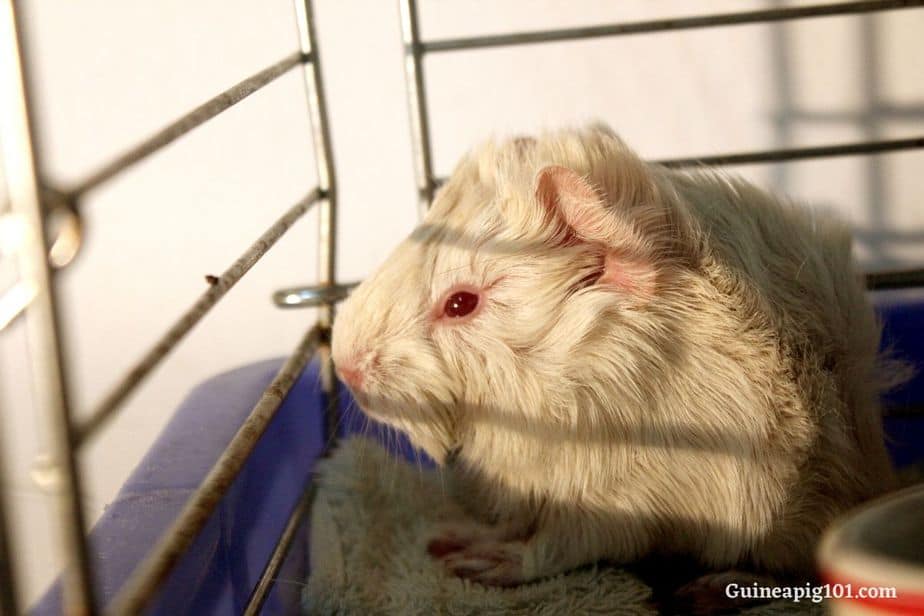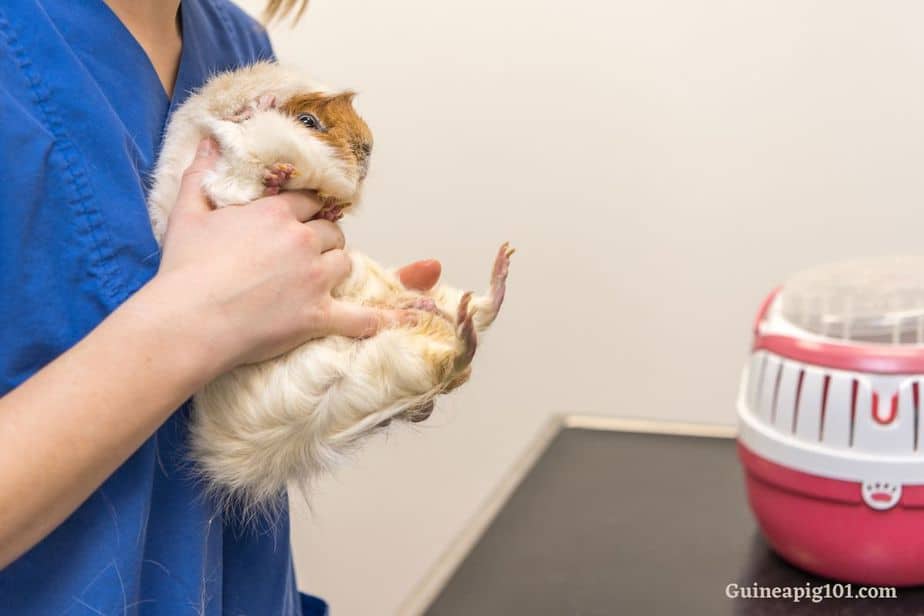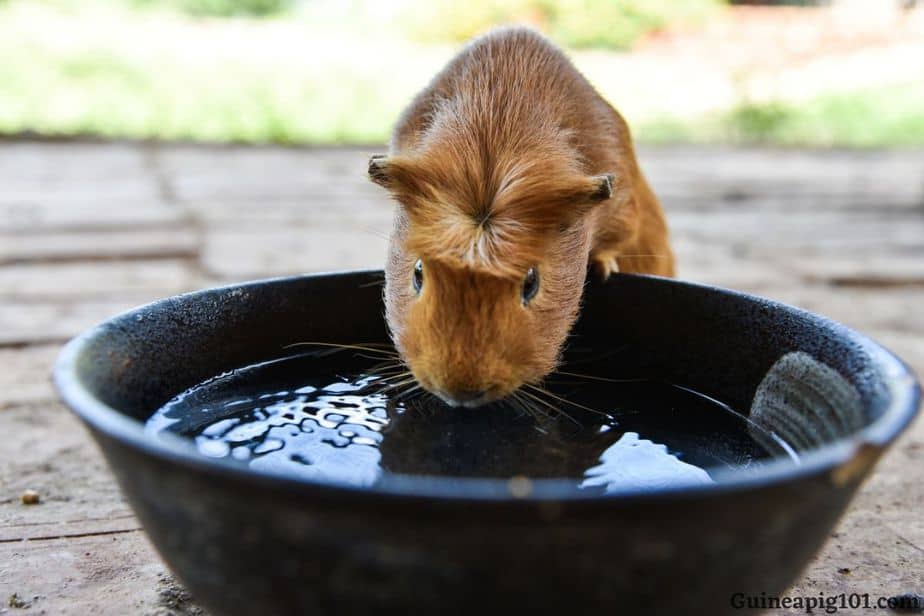Guinea pigs may ingest their fur while grooming themselves. The ingested fur is expelled as fecal waste, but in some cases, it sticks to the digestive tract forming hairballs. The hairballs are also referred to as wool blocks.
Guinea pigs can ingest fur while grooming, which can result in hairballs. Diet rich in fiber helps remove hairballs. Guinea pigs should be fed with a large quantity of timothy hay along with water. These should help to shift hairballs. If the problem persists, then refer to your veterinarian.
In the further sections, we will discuss guinea pigs having hairballs, its causes, and symptoms.
The treatment for the problems and the measures to be taken to prevent it. The home remedies you can choose to cure the problem. So, read the article till the end to learn all about it.
What are hairballs in guinea pigs?
Hairballs, as the name suggests, is the clump of hair present in the digestive tract and the stomach. The clump also holds undigested food particles along with it.
You may hear a few other names of the hairballs like “furballs” or “trichobezoars.” The last name is a scientific term used for hairballs.
Animals having fur and a habit of licking themselves are likely to possess this problem.
Animals, while grooming, ingests fur by mistake. Shedded fur can also be swallowed along with the food and water.
As the pet animals spend most of the time at one location, the fallen hair will likely accumulate nearby. These hairs can be easily ingested if mixed with food or in the water bowl.
Ingestion of hair is an everyday activity for various animals. These hairs can pass through the digestive system in most cases.
In a few instances, the hair ingested rolls together, forming a ball and gets stuck in the stomach or intestines.
These hairs need to be removed from the body. The animal can vomit or expel hairs through feces. However, as guinea pigs cannot vomit, the only way that remains is via eliminating.
Guinea pigs are unable to expel large clumps of hair in the digestive tract. They get stuck in the gastrointestinal tract and form a blockage.
Slowly guinea pigs will stop eating and drinking. This condition is known as wool block and needs immediate intervention.
Guinea pigs having long hair or hair not correctly trimmed are highly susceptible to this problem.
Hair fall is more associated with the diet of guinea pigs. Moreover, guinea pigs are likely to suffer from this disease compared to other animals.
Do guinea pigs cough up hairballs?
Guinea pigs do not vomit. So, when hairballs are stuck inside the stomach, guinea pigs are likely to suffer due to the wool block and won’t cough.
The hairball cannot be thrown out through the mouth. It needs to pass through the digestive tract only.
Guinea pigs having a healthy gut can push the hair clumps out as feces. The digestive system showing proper peristaltic movements can move hair through and do not let the formation of hairballs.
In case there is a problem due to the congestion of larger hairballs, the guinea pig may suffer from acute peritonitis.
That results in infection in the inner lining of the intestines. That can lead to the death of the guinea pig if immediate action is not taken.
Common causes of hairballs in guinea pigs
Guinea pigs are prone to hairballs by default. Their lifestyle of grooming themselves results in the formation of hairballs.
They ingest their fur in the process. If the guinea pig has a healthy digestive system, then hairballs won’t form.
Excess of hairs ingested together is likely to form clumps. These clumps get stuck in the stomach. The reasons behind the hairballs in the stomach are:
- Obsessive grooming (barbering). Guinea pig under stress and feeling bored tend to groom themselves more. Again guinea pigs lacking physical activity and unavailability of chewing their toys are likely to suffer from hairballs.
- Lack of brushing. Fallen fur stays on the body surface, which should be removed regularly. It becomes necessary during the molting season.
- Diet having low fiber. A healthy digestive system is ideal for digesting and pushing the ingested fur. Fiber is essential to keep the digestive system in good condition. That stops the formation of clumps of hair.
- Not drinking enough water. Water is another factor that helps in the digestion of the food.
- Another sickness. Guinea pig suffering from some disease earlier may have a weak digestive system. Gastrointestinal (GI) stasis is an example that slows the movement inside the gut. That allows the accumulation of hair at a place and leads to the formation of hairballs.
If your guinea pig is suffering from GI stasis then they should be taken to vet immediately as it is a critical situation for guinea pigs.
Guinea pig hairballs symptoms

Guinea pigs have an instinct to maneuver their weakness. They will behave normally, even if they are suffering and vulnerable to their enemies.
So, you may make a mistake while diagnosing such problems in guinea pigs. However, you should look for the following symptoms:
- Loss of appetite: The Guinea pig will avoid eating if it has hair stuck into its stomach. If the gut is completely blocked, then the guinea pig will stop eating altogether.
- Changes in poop: A decrease in fecal pellets will also accompany a loss in appetite. The Guinea pig will have a constipation problem while suffering from the wool block.
- Behavioral changes: Look if there is any change in the behavior of the guinea pig. It will stop running around, or please you for treats. Instead, it will remain silent and depressed.
- Pain: Teeth grinding is an indication of anxiety. Guinea suffering from anxiety can be observed by grinding its teeth.
- Lethargy: Guinea pig not even willing to move due to pain and suffering.
These symptoms are indicating a problem in the digestive tract. This problem can be due to various reasons. It might be possible that hairballs are not the cause of the problem.
The guinea pig should be taken to a veterinarian for the diagnosis. Only after the examination one can confirm the presence of hairballs in the stomach.
Guinea pig poop mixed with hair
Guinea pigs will give out hair mixed with their droppings. It is usual as they ingest hair now and then while grooming themselves. This hair passes through the gut and is expelled through the anus.
If you observe hair in the poop of guinea pigs, then don’t come to any conclusion. Hair in the poop does not mean the guinea pig has hairballs.
Till your guinea pig is eating food, drinking water, and playing, you should not be concerned. Hair in the poop is a good sign that the digestive system functions correctly and gives out any hair ingested.
The presence of excess hair in the droppings indicated that the guinea pig is ingesting too many hairs. You should look for the cause as the guinea pig may be having hairballs anytime soon.
It is a matter of concern the dropping is badly coiled up with hairs. You need to take preventive measures before the problem increases.
How to treat hairballs in guinea pigs

Once you sense the presence of hairballs in your guinea pig’s stomach, visit a vet for the check-up of your pet. The vet will confirm the presence and extent of hairballs in the stomach.
The Guinea pig will be examined thoroughly. You may be asked about the symptoms and the extreme diet and droppings. The vet will check for the presence of any unwanted mass inside the digestive tract.
After the confirmation of the blockage due to hairball, the veterinarian will begin the treatment. The size and number of hairballs are also essential to determine the treatment. General therapies will be the following steps:
- Abdominal massage: Movements of the digestive tract help push the wool block along and remove the clog. Don’t try to do the massage yourself at home as it may hurt and cause damage to the delicate body parts of the guinea pig.
- IV fluids: Fluids are essential to hydrate the system of the guinea pig. This will activate the digestive system. The vet also gives a fiber-rich mixture.
- Pain relief: The Guinea pig will suffer from severe pain due to hairballs. Pain relievers or analgesics are given to alleviate the condition.
- Digestive stimulants: To improve the gastrointestinal tract movement, medication is given. Once the peristaltic movements start, the hairballs will be given out.
- Enzyme tablets: Tablets containing enzymes to decompose the hairballs. The hair is made of a protein called keratin, which can be broken down with enzymes’ help.
- Hairball removal surgery: In some extreme cases, surgery may be done to remove hairballs.
The veterinarian may ask you for the home treatment if the hairballs are small enough. The vet will go for surgery if nothing else is working to remove the hairballs.
Can guinea pigs die from hairballs?
A Guinea pig may recover from the wool block or may succumb to death. That will depend on the early diagnosis of the problem and the size of the hairball.
Enzyme tablets can decompose or break down hairballs of average size. The hairball will slowly pass through the gut with the fiber food and be given out through the anus. However, you must only use it if it is recommended by your vet.
If there has been continuous deposition of hairballs in the stomach leading to a significant size blockage, then the hairball will be challenging to remove.
Surgery done to save the guinea pigs is also not much successful as the guinea pigs may not survive the surgery. A Guinea pig may face death with the ongoing problems of clogging.
Pain, stress and the infection will be tough to bear out for the pet.
Wool block causes the death of the guinea pig in almost half of the cases. If not treated, the guinea pig will not be able to survive. So, you should consult your vet immediately when you doubt the possibility of hairballs.
Home remedies for hairballs in guinea pigs
You can do home treatment for the underlying problem. But a visit to the vet is must to confirm the presence of hairballs and size of it.
The vet will also recommend home treatment in some cases. You can go for the following home treatments if the hairballs are small enough.
Fiber and Water

Guinea pigs having a healthy digestive system can clear out the hairballs. Fiber is an essential ingredient of food that keeps the digestive system healthy.
You should stop feeding pellets, and timothy hay should be provided as much as possible. Timothy hay has high fiber content.
A Guinea pig may reject to chew timothy. Then you can mix it with alfalfa hay. Alfalfa hay has higher calories than guinea pig will like it.
Also, the pellets are made of alfalfa hay so that the guinea pig will have a familiar taste. You can also offer a few high fiber snacks like:
- Raspberry and blackberry twigs
- Apple and pear branches
- Willow branches
Provide your guinea pig with an ample amount of water. Water helps to soften the wool block and natural movement in the gut.
Make sure that the guinea pig is drinking water. If not, then pour some water along with its diet like giving leafy vegetables in water.
You can also mix banana mashed in the water bowl to enhance the water’s taste and flavor.
Also read: How much water do guinea pigs need?
Pineapple Juice
Pineapple juice is also used to treat hairballs. Hair is made up of protein, which can be dissolved by suitable enzymes.
Pineapple juice contains one such enzyme called bromelain. Papaya also contains an enzyme called papain, which can dissolve proteins.
Although there has been no such scientific study related to the benefits of pineapple and papaya, it is also said that the high pH level of the guinea pig’s stomach will make the enzymes ineffective.
Pineapple and papaya have a high sugar level, which can be harmful to your pet, so avoid feeding pineapple and papaya in large quantities.
Mineral Oil
Mineral oil, also known as paraffin oil is also an excellent alternative to clear the blockage. It acts as a lubricant for the digestive tract, allowing the movement of the things stuck with the digestive tract walls.
Your vet will recommend the dosage of mineral oil if the hairball size is small. Minor cases of the wool block can be quickly resolved with its use.
One must note that mineral oil can have a negative impact if the hairball is massive. It will act as a coating for the giant hairballs making it waterproof.
Then it will be difficult to decompose the hairball. So, you should use mineral oil once approved by the veterinarian.
Hairball Relief Paste
You will find products in the market designed to provide relief to guinea pigs when suffering from the wool block. These are available in the form of a paste.
This paste, also is known as hairball paste, is a mixture of high fiber foods and fruits. It acts as an appetizer and also helps in clearing the hairball clog.
The paste does not contain any medicines; it only serves as a high-fiber food that can be easily swallowed.
They do not have any side effects, and so you can use them without any fear. Still, they are not much of use for massive hairballs.
You should be careful while purchasing the products that it is safe to use for guinea pigs. Such paste is also available for other pet animals.
How to prevent hairballs in guinea pigs

It is always better to avoid the problem from occurring than to find a remedy. The following steps will help you prevent hairballs in guinea pigs:
- Brush: Regular brushing helps remove the hair that your guinea pig could swallow while grooming itself. It becomes a must during the molting season. You will find a brush designed for small animals.
- Vacuum: Vacuum cleans the enclosure to remove any hair fallen nearby. Also, clean the water bowl and food plate.
- Chew toys: Toys can be used to distract the attention of the guinea pigs. They will be busy playing instead of grooming themselves. Wooden toys have an extra advantage as it increases the fiber intake of guinea pigs.
- Exercise and enrichment: Guinea pigs under stress or feeling bored tend to groom themselves more. Practice and play help to reduce grooming activity.
- Extra fiber: Diet rich in fiber helps keep the digestive system healthy and does not allow the hairballs to stick in the gut. Provide guinea pig with unlimited timothy hay and leafy vegetables.
- Monitor water intake: Water intake should be regularly monitored. The Guinea pig should be drinking ample water. Keep a fresh water bowl in the hutch every day.
Hairball’s formation cannot be prevented entirely. Still, you need to take care to avoid or minimize the hairballs getting in the gut. Wool blocks can be controlled with preventive measures.
Sources: Fecal impactions, Constipation and Obstipation in Small Animals, GI stasis in guinea pigs.
